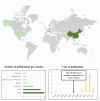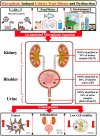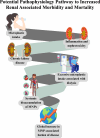Plastic induced urinary tract disease and dysfunction: a scoping review
- PMID: 39217203
- PMCID: PMC12401723
- DOI: 10.1038/s41370-024-00709-3
Plastic induced urinary tract disease and dysfunction: a scoping review
Abstract
Introduction: In 2019 the World Health Organisation published a report which concluded microplastics in drinking water did not present a threat to human health. Since this time a plethora of research has emerged demonstrating the presence of plastic in various organ systems and their deleterious pathophysiological effects.
Methods: A scoping review was undertaken in line with recommendations from the Johanna Briggs Institute. Five databases (PubMed, SCOPUS, CINAHL, Web of Science and EMBASE) were systematically searched in addition to a further grey literature search.
Results: Eighteen articles were identified, six of which investigated and characterised the presence of microplastics and nanoplastics (MNPs) in the human urinary tract. Microplastics were found to be present in kidney, urine and bladder cancer samples. Twelve articles investigated the effect of MNPs on human cell lines associated with the human urinary tract. These articles suggest MNPs have a cytotoxic effect, increase inflammation, decrease cell viability and alter mitogen-activated protein kinases (MAPK) signalling pathways.
Conclusion: Given the reported presence MNPs in human tissues and organs, these plastics may have potential health implications in bladder disease and dysfunction. As a result, institutions such as the World Health Organisation need to urgently re-evaluate their position on the threat of microplastics to public health.
Impact statement: This scoping review highlights the rapidly emerging threat of microplastic contamination within the human urinary tract, challenging the World Health Organisation's assertion that microplastics pose no risk to public health. The documented cytotoxic effects of microplastics, alongside their ability to induce inflammation, reduce cell viability and disrupt signalling pathways, raise significant public health concerns relating to bladder cancer, chronic kidney disease, chronic urinary tract infections and incontinence. As a result, this study emphasises the pressing need for further research and policy development to address the challenges surrounding microplastic contamination.
Keywords: Incontinence; Inflammation; Kidney; Microplastic; Nanoplastic; Urinary tract; Urine.
© 2024. The Author(s).
Conflict of interest statement
Competing interests: The authors declare no competing interests. Ethics approval: This manuscript is a review article and does not involve a research protocol requiring the approval by the relevant institutional review board or ethics committee.
Figures






References
-
- Walker TR, Fequet L. Current trends of unsustainable plastic production and micro(nano)plastic pollution. TrAC Trends Anal Chem. 2023;160:116984.
-
- Microplastics in drinking water World Health Organization World Health Organization 2019 28/08/2019. Report No.: 978-92-4-151619-8.
-
- Lim X. Microplastics are everywhere—but are they harmful. Nature. 2021;593:22–5. - PubMed
Publication types
MeSH terms
Substances
LinkOut - more resources
Full Text Sources
Research Materials

